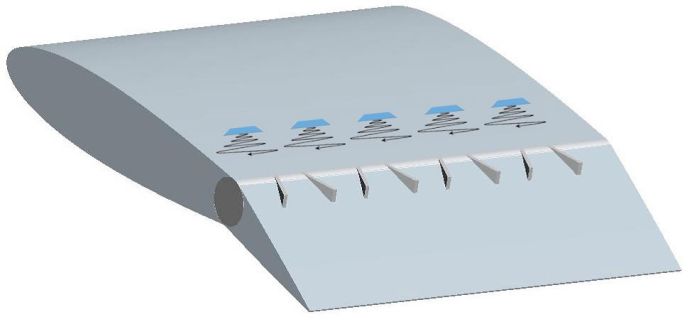Topic: COMMUNITY INTEREST

Hybrid Flow Control Method for Simple Hinged Flap High-Lift System

- Hybrid flow control enables utilization of proven vortex generator technology in high-lift configurations, while eliminating the (device-induced) parasitic drag in cruise.
- Hybrid flow control provides the necessary lift enhancement for a simple hinged flap high-lift system.
- Hybrid flow control approach is more compatible with the limited supply of engine bleed air available as engines idle during the landing descent.
- Method can reduce aircraft drag by up to 3.3 counts due to elimination of Fowler flap fairings.
- Technology is also useful for increasing the effectiveness of vertical fin / rudder systems. This leads to reduced fin size and weight, especially for the short variant of a transport aircraft.
- Aerospace: All hinged flap control surfaces (e.g., flaps, elevators, and rudders) of commercial and military aircraft.
- Marine: All hinged flap control surfaces (e.g., hydroplanes and rudders) of marine vessels.
The combination of AVGs with SWJ actuators creates an unparalleled and unexpected improvement in flap efficiency. This unique hybrid approach of using SWJ actuators and AVGs in combination may provide the necessary lift enhancement for a simple hinged flap high-lift system while keeping the pneumatic power requirement (mass flow and pressure) for the SWJ actuators within an aircrafts capability for system integration. For the current innovation, it is envisioned that this hybrid approach may significantly narrow/close the technology gap and enable the realization of a simple hinged flap high-lift design, which will have the benefits of lower weight (without the Fowler flap mechanism) and less cruise drag (without the external fairing for the Fowler flap mechanism). Figure 1 illustrates one example of how AVGs and the SWJ actuators can be used in combination for a simple hinged flap high-lift system. For high-lift applications with a high flap deflection angle and a significant adverse pressure gradient, both SWJs and AVGs are activated for hybrid flow separation control. When the flap is deflected to a low deflection angle, only AVGs are activated to prevent possible flow separation initiated from the trailing edge. Figure 2 shows the cruise configuration with no flap deflection and there is no flow control activation.
